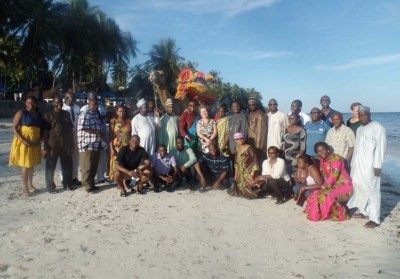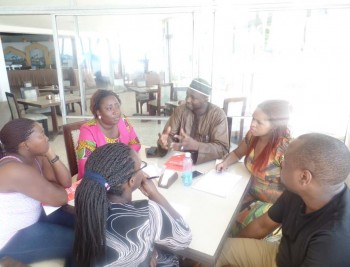On Friday the 11th of December 2015, the 51st SINA Health PBF course ended in Mombasa with 29 participants: from Nigeria (13x), Kenya (7x), Liberia (5x), Lesotho (3x) and Switzerland (1x).
From day one, the group has been engaged in lively discussions and nice exchanges at the border of the Indian Ocean. The chief aim of the course remains of course to learn from each other and for everyone to incorporate as much as possible the rapid new developments in PBF of the last few months into everybody’s country design.
COUNTRY SPECIFIC RECOMMENDATIONS
- KENYA
Despite the fact that health expenditures has considerably increased between 2001 and 2014 the funds allocated to health care remain inadequate with 6% of total government expenditure against the Abuja norm of 15%. Yet funding may not be the main problem in Kenya but rather the distribution of those funds among the primary, secondary and tertiary level and the cost-effective use of the funding in general. Following the new Constitution, Kenya is engaged in an administrative devolution process of services towards a novel system with 47 autonomous Counties. Lessons learned and mistakes committed are gradually becoming available. The World Bank supported RBF program runs out by the end of 2016 with the idea to scale up RBF to 20 more counties from 2016 onwards. A new program with the World Bank and JAICA is currently being negotiated. The Kenya participants to the PBF course conducted the PBF feasibility scan, which produced the low score of 22%.
The Kenya recommendations are the following:
-
Advocate for change in the funding to comply with at least 3 USD per capita for the new RBF program of 2017 onwards.
- Collaborate with NGO’s to initiate community verification in all the counties.
- Advocate that facilities participating in PBF have autonomy as PBF best practice.
- To advocate that facilities have right to purchase inputs from any accredited supplier and not only from KEMSA.
- PBF unit to have further discussions with the County Departments of Health on the need for CDV Agency.
- Lessons learned from Samburu indicated that it is best conduct supervision and quality verification together with support of development partners at each county.
- Inclusion of CDV Agencies at the Counties in the budget in the proposed PBF project.
- Increase the number of RBF indicators at basic health package level from the current vertical ten towards a more horizontal package of at least twenty.
- Facility managers should be allowed to buy their inputs from accredited distributers instead of receiving drugs from the central medical stores (KEMSA).
- Assess how much funding may be available in the various programs post 2016 (2017-2022), notably the new 150 million US$ program currently discussed with the World Bank and the further funding from the Japanese government for health systems improvement.
- To cost out the required budget for a multi-annual RBF program on fully-fledged PBF program for example in 4 counties to be followed gradually by the other of the 21 selected counties.
- To organize a senior-level workshop for the key policy makers (CS, PS, CMS, Head Policy, Planning and Finance and their staff) in which the potential of a mature RBF program would be discussed.
2. Lesotho
The country allocates 14.5% of its public budget to health. Together with the out-of-pocket payments and donor contributions the total per capita health expenditure is a considerable USD 123.4 per capita per year. The main health problem in Lesotho is HIV/AIDS with a prevalence of 23%, also being the main cause of mortality. The maternal mortality rate is equally high with over 1000 deaths per 100,000 live births.
The Lesotho team identified the following bottlenecks for the implementation of PBF:
- Delays in financial flows and management towards health facilities
- Government health facilities are not allowed to open own bank accounts at facility level, with long delays in funds reaching the facilities.
- Lack of a systemic approach of the village health workers system in Lesotho. There are no formal indicators for incentivising VHWs, even though a division: 40% – facility improvement, 30% – personal bonuses and 30% – Village health workers has been proposed. There are the unusually high number of around 100 VHWs per facility.
- The hospital Lesotho PBF scheme is still limited by only financing the MCH indicators and not allowing individual performance payments to staff. In addition hospital indicators are a mix of primary care and secondary level ones and several go unreported.
Lesotho recommendations
- Negotiate opening HF bank accounts, by proposing an experiment to the Accountant General with opening bank accounts and funds being transferred directly. Fro this the in-charges require to improve their basic financial management skils.
- Develop SMART indicators for VHW program. The HF in-charge should select the adequate number of active VHWs to use.
- A new PBF hospital design is proposed to pay against quality of care measured by departments and paid against a fixed overall cap allocated per hospital.
3. Liberia
The PBF feasibility scan conducted by the Liberia team showed a score of 42%.
Liberia recommendations
- Hold a meeting with the Deputy Minister for considering PBF in program activities also for public health emergencies.
- Advocate with Senior Management Team (SMT) to utilize PBF mechanisms to allot PBF budgets to facilities, to present to them the documentary evidence for facility autonomy and to present documentary evidence of facility autonomy to procure drugs.
- Assess the feasibility of introducing CDV agencies approach with involvement of private and faith-based institutions
- Advocate with donor agencies through the SMT to better coordinate financing flows and adopt performance financing
- Reinforce the setting up of indicators with the focus on quality, equity and efficiency. Strengthen collaboration with MOH relevant units, including Quality Management Unit to define PBF quality indicators
- Conduct a mapping exercise to identify PBF partners at other government and MOH agencies and establish a national PBF taskforce
- PBF steering committee to engage community members for selecting organisations to conduct client satisfaction surveys
- Discuss with key stakeholders at MOH to conduct the evaluation household and quality studies. Work with Research Unit to design protocol to conduct baseline survey for PBF at selected hospitals
- Meet with key management staff to clearly define the chain of communication at primary and hospital level PBF
- Facilities on a contractual basis to develop business plans
- Work with key stakeholders to introduce equity bonus into the PBF program to capture hard-to-reach areas
- Organize a two-weeks training orientation meeting for political buy-in to PBF concepts for key stakeholders on PBF.
4. Nigeria
PBF started in 2011 in Ondo, Nasarawa and Adamawa States in Nigeria with a loan of the World Bank and administrative support of the National PHC Development Agency (NPHCDA). The program was scaled up in 2015 to 50% of the Local Government Authorities (LGA) in these three states. Yet the other 50% control LGA’s still maintain the DFF study approach. The PBF program considerably improved output and quality of the services and there is great enthusiasm. Once fully rolled out the main problems that PBF could potentially reduce the inequalities between the Northern and the Southern States in Nigeria. Moreover it could reduce maternal mortality, which is high by global standards. With the recent political changes in Nigeria, PBF could also become a major instrument for the new government to enhance transparency in the social services and to assure that public resources indeed reach the beneficiaries. PBF may also provide the instruments to strengthen and rehabilitate health facilities in Nigerian directly affected by political turmoil in the Northern States. The NPHCDA proposes to extend the PBF program to some of the Northern and North-eastern states of Nigeria, and for this the World Bank loan program “Save-One-Million-Lives” of 500 Million USD funds may be pledged.
Ondo State
Ondo State has very positive experiences with PBF since 2011. The PBF feasibility scan conducted by the Ondo participants showed a high score of 94%. Yet, the private and religious health facilities are not yet included in the PBF program. Moreover, there is poor quality and quantity of services at Decentralized Facility Financing (DFF) facilities. These DFF facilities were meant as a study arm of the World Bank impact study, produced according to all observers’ significantly less promising results, but are still maintained.
Ondo State recommendations
- Introduce an urban PBF approach in the cities
- Survey all public / private / faith based health facilities (accredited or not)
- Validate the data collected at the LGA authorities and create consensus on existence of facilities and their accreditation
- Define the population served in each catchment area and service package offered.
- Organise workshop with all private facilities to obtain final consensus and approval of the health facility survey data and the selection of primary and secondary contract holders
- Conduct PBF training for retained health facilities
- Negotiation and signing of contracts
- Transfer all DFF health facilities into the PBF approach.
- Discussion with the national PIU/WB
- Categorization into main and secondary contract holders
Northern States in Nigeria
The Northern States were requested by the NPHCDA to propose action plans on how to start PBF. For this reason, we welcomed 9 participants from 4 States in Mombasa.
The main recommendations for introducing PBF in the Northern States are:
- Assure sufficient funding for the new PBF pilots in each State and target for achieving adequate economies of scale a population of between 300,000 and 700,000 per State. The costing for these pilots would then be approximately USD 1 – 2 million per year per State.
- Target and pilot PBF in 2-3 Local Government Authorities in each State with all health facilities at primary and hospital level. This would include the regulatory authorities and the CDV Agencies at State and LGA levels.
- Negotiate sufficient funding with Federal level not only from the “Safe 1 Million Lives” project but also from any other Nigerian State or Federal level budget lines.








